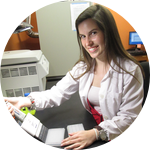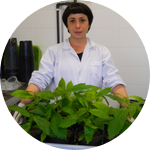About This Project
P. cinnamomi destroys natural plant communities across the globe. We are developing a study aiming to understand the mechanisms of resistance to this pathogen in a resistant host, the japanese chestnut, using three different approches: transcriptomics, linkage mapping and hispathology of infection. The final goal is to identify candidate genes, pathways and markers linked with the resistance, for future genome selection of improved genetic materials
Ask the Scientists
Join The DiscussionWhat is the context of this research?
Phytophthora cinnamomi is one among the most destructive pathogens associated with the decline of forestry, ornamental and fruit species, as well as of some 900 other woody perennial plant species (Ferraris et al. 2004 http://onlinelibrary.wiley.com.). When introduced to an environment, this pathogen has had enormous impacts on natural systems, and has been shown to reduce the native biodiversity in Europe, the USA, Australia, New Zealand and Africa. We want to understand the mechanism of resistance in a resistant host, the japanese chestnut, to select candidate genes and markers, that may be involved in the resistance mechanisms, and to create a reference population, from controlled crosses, to apply genome selection in the future, for improved genetic materials.
What is the significance of this project?
There is considerable variation in response to infection by P. cinnamomi amongst host species. We took the advantage of that fact, and selected a resistant species, the japanese chestnut, as a model, to study its mechanisms of resistance to the progression of the pathogen. We made controlled crosses using this species as donor of resistance, to produce a segregant population for the trait, that is the basis for further genomic studies. The understanding of the mechanisms of resistance will allow a DNA based selection of improved genotypes, with resistance to the pathogen, adapted to different soil and climate scenarios. The genomic resources generated under this project, will be an asset for many plant communities across the world that are also affected by P.cinnamomi.
What are the goals of the project?
The project aims to develop new genomic tools, to select faster and more efficiently improved genetic materials, with increased resistance to the pathogen, through selective breeding. The method consists on genotyping and phenotyping all the progenies from crosses, made between two parents with contrasting susceptibilities to the pathogen, to make an association between the genotype and the phenotype. Activities aims will foster the selection of new improved genetic materials and also to engage outreach activities, to inform the farmers about the new product developed under the project and the new tools and strategies for integrated management, to reduce the economic impact of the disease caused by P.cinnamomi.
Budget
The budget will pay five months' grant for a young scientist to pursue the work that has been done till now. The grantee will genotype and phenotype the crosses of 2016 and also the F2 population that we got for the first time this year, 10 years after we made the first controlled crosses. The grantee will also be responsible for the maintenance of F1 and F2 populations, which is crucial because this is the basis of the research program. These tasks will take approximatly 5 months to be completed. The result will be the saturation of the genetic linkage map to identify the Quantitative Trait Loci, the regions in the genome linked with the resistance to the pathogen. The main aim of this crowdfunding is to proceed the research program without intererruption until we get a new funded project. This is very important for the success of the program, since the results we obtained so far are very promising.
Endorsed by
Meet the Team
Affiliates
Affiliates
Affiliates
Affiliates
Team Bio
Carmen Santos - Genetics and Genomics
Patrícia Fernandes - In vitro culture and histopathology
Sara Tedesco - In vitro culture and study of graft incompatibility
I am their supervisor
Rita Lourenço Costa
I am a senior research scientist at INIAV – The Portuguese National Institute for Agriculture and Veterinary Research, with a degree in Forestry and PhD in Plant Biotechnology, both from the University of Lisbon. I am Head of Molecular Biology Lab of Forest Research Unit of INIAV. My research interests are related with Biotechnology, Molecular Biology, Genetics and Genomics of Woody Species, including Castanea sativa Mill, Quercus suber L, Pinus pinea L and Pinus pinaster Ait. The work developed in recent years has focused on the use of molecular markers to assess the genetic structure of populations of chestnut, maritime and stone pines and the use of genomic tools for understanding the genetics underlying various aspects of the trees’ biology that condition, namely, the yield and quality of cork in cork oak and disease resistance in chestnut and maritime pine, namely chestnut root rot disease caused by Phytophthora cinnamomi and pine wilt disease caused by the pine wood nematode, Bursaphelenchus xylophilus. Currently I am coordinating the research program: "Understanding disease resistance to Phytophthora cinnamomi in Castanea sp", developed in partnership with four Portuguese research institutions: UTAD, BIOFIG-FFCUL, ESAC and ITQB/UNL, a nursery company CERTIFRUTEIRAS, and with the collaboration of researchers of The American Chestnut Foundation, Clemson University and the scientific advisory of Dr C. Dana Nelson, Research Geneticist and Project Leader of Southern Institute of Forest Genetics (SIFG) and Co-Director of Forest Health Research and Education Center - University of Kentucky. I was a Fulbright Visiting Scholar at Clemson University, University of Kentucky and Southern Institute of Forest Genetics in the academic year of 2015-2016.
orcid.org/0000-0001-9503-6126
Carmen Santos
I am biologist, I finished the bachelor degree in Cell Biology and Biotechnology in 2008 at the Faculty of Sciences, University of Lisbon. In 2010, I obtained the master degree in Cell Biology and Biotechnology at he same University, with the presentation of a thesis entitled "Isolation of Phytophthora cinnamomi resistance genes and defining a protocol of genetic transformation in Castanea sativa".
My scientific activity was initiated in 2010 as a research fellow in the project PTDC/AGR-CFL/101707/2008- "Understanding resistance to pathogenic fungi in Castanea sp.," participating in all project tasks. Since 2013, I am developing my PhD project entitled "Genomic approaches to understand the genetic response to Phytophthora cinnamomi Rands in Castanea sp.” at the National Institute for Agricultural and Veterinary Research (INIAV) and New University of Lisbon (ITQB-UNL).
Understanding how different Castanea species or genotypes could resist to P. cinnamomi infection has been a great challenge. I believe that the answer to the complexity of resistance to P. cinnamomi is only possible integrating different approaches. Therefore, based on a hybrid population of susceptibe European chestnut x Japanese chestnut (resistant species), several studies have been performed in phenomics, transcriptomics and genomics. My academic career has taken advantage from those different scientific areas.
In the context of my PhD project, I was three months in the United States in different scientific institutions: University of Kentucky, Clemson University, Southern Institute of Forest Genetics, Southern Research Station, USDA Forest and The American Chestnut Foundation.
I am author of more than 20 publications in scientific meetings, 1 scientific article in a national journal peer-reviewed and 4 articles in
international journals peer-reviewed.
Sara Tedesco
I studied Rural Development Cooperation in Italy, volunteered in Sierra Leone and lived in close contact with Indian farmers during my BA thesis. There, I became familiar with the concept of sustainable development and matured sensibility for the challenges that humanity is facing so I decided I would become an agronomist to help people to grow out more efficiently and produce for their needs.
I moved to Portugal where I achieved a 2nd Bachelor and a Master degree in Agronomic Engineering, developing a special passion for perennial trees, a sector in which plant material for plantation constitutes an investment that will lasts several decades. I specialized in production systems and developed my Final MA thesis, as well as a scientific paper publication, in modeling water and nitrogen in Lisbon urban farms.
Since March 2015 I am holding a research grant under the project: PRODER 53593 - "Inov Cast - Innovation in chestnut production chain: competitiveness and sustainability" integrated in the Portuguese breeding program for chestnut resistance to ink disease and I take care of the propagation of new improved chestnut rootstocks. I love what I do, not only because there is no day in which I do not learn something new but also because I know that my work is needed and important for all those farmers that are facing economical injuries and are abandoning the orchards.
I recently got the opportunity to collaborate with the Agrifood research and technology center of Aragon (Spain) researching the graft compatibility of our improved chestnut hybrids mainly based on histology of in vitro calli and micrograft unions. Considering that graft incompatibility can manifests several years after the union, the aim is to early detect the compatibility trait of different graft combinations and thus to shorten the time it takes for improved genotypes to be ready for farmers.
Patrícia Morais Fernandes
I’m a young biologist with a Master degree in Plant Biotechnology from University of Coimbra (Portugal). During my master thesis I worked in the field of plant biotechnology, namely in the optimization and molecular analysis of the somatic embryogenesis process in solanaceous species. This project included work in different fields such as plant in vitro culture, molecular biology, physiology and microscopy. Part of the developed work was presented as poster in the 3rd International Conference of the International Union of Forest Research Organisations (IUFRO) that took place in Vitoria (Spain), 2014.
After my Master's thesis, I transited to the industry sector by working as a researcher in the UC-InProPlant Association, where I performed protocol optimization for in vitro culture of several fruit and woody trees.
Nowadays, I am a research fellow in the project Proder 53593 "InovCast - Innovation in chestnut production chain: competitiveness and sustainability", at the Molecular Biology Laboratory of Forest Systems in INIAV IP.. This work is in the scope of the Castanea sativa (European chestnut) breeding program for the pathogen Phytophthora cinnamomi. My main work lines are 1) Controlled crosses between the susceptible (European) and resistant (Asian) chestnut species; 2) Mass production of P. cinnamomi resistant hybrids through in vitro culture; and 3) the understanding of the pathogens invasion pattern in the root system of Castanea spp. through histopathology. I also follow the genomic, phenomic and transcriptomic approaches performed in the scope of this project.
Additional Information
na
Project Backers
- 7Backers
- 6%Funded
- $254Total Donations
- $36.29Average Donation





